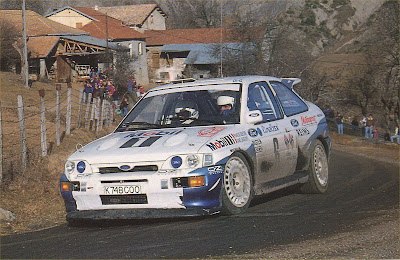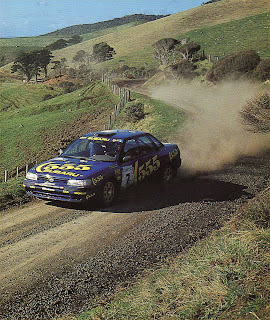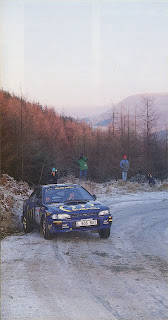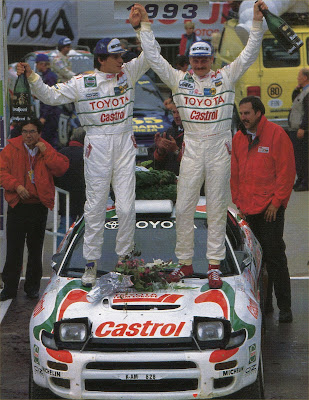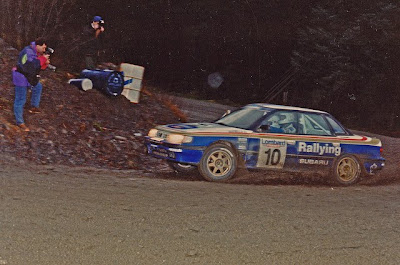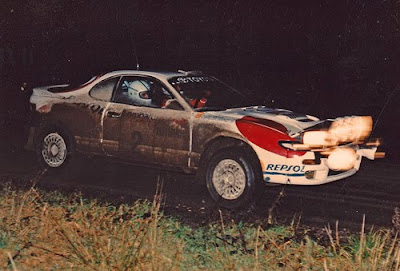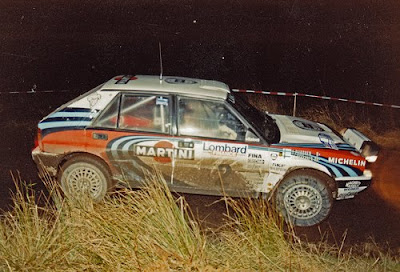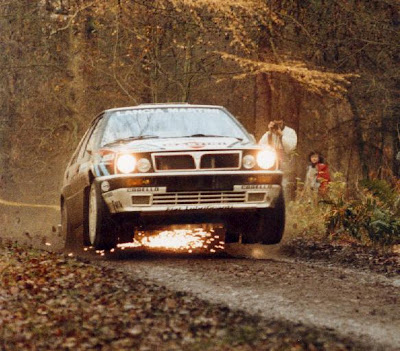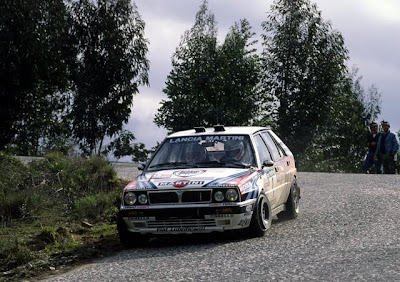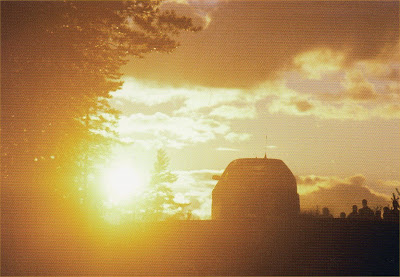Hard to think, but just three years earlier us British fans had despaired of ever having another World Rally winner. That Jimmy's boy should become the youngest ever World Champion (a record that still holds) was beyond our wildest imagination.
It was a season of two halves and at the mid point it would have been a rash investor who put his money on the Scot lifting the trophy at the end of the year.
He'd crashed on sheet ice on the Monte, broken down in Sweden, finished a dutiful third in Portugal and struggled to fifth in Corsica and was lying joint sixth in the championship.
 Out in front was Carlos Sainz, who's breezed the Monte and snatched victory in Portugal on the last stage from Kankkunen's Toyota. Sweden had belonged to Mitsubishi, whose new Lancer was showing plenty of pace and Corsica had, as usual, been dominated by the French.
Out in front was Carlos Sainz, who's breezed the Monte and snatched victory in Portugal on the last stage from Kankkunen's Toyota. Sweden had belonged to Mitsubishi, whose new Lancer was showing plenty of pace and Corsica had, as usual, been dominated by the French.That was May, then in June Sainz went mountain biking. A safe enough sport compared to driving a rally car at 100mph you'd think, but not for Carlos. He fell off and tore ligaments in his shoulder. He needed an operation, and physiotherapy, and ended up missing the Rally of New Zealand.
 What would have happened if he'd been there is anyone's guess, but New Zealand was where McRae won his first rally and its long stages suited the flamboyant Scot down to the ground. He inherited the lead when Tommi Makinen crashed his Lancer, and he also benefited from Delecour being ill and the Toyotas not being at their best on the twisty stages. However as he was 35 seconds faster than anyone else on the longest stage it would probably have always been McRae's rally. This is what he was best at.
What would have happened if he'd been there is anyone's guess, but New Zealand was where McRae won his first rally and its long stages suited the flamboyant Scot down to the ground. He inherited the lead when Tommi Makinen crashed his Lancer, and he also benefited from Delecour being ill and the Toyotas not being at their best on the twisty stages. However as he was 35 seconds faster than anyone else on the longest stage it would probably have always been McRae's rally. This is what he was best at.For Australia though Sainz was back. He didn't exactly set the stages alight, and when a fallen tree pierced the radiator his rally was over and so it was back to McRae to uphold Subaru honours. The rally belonged to Kenneth Eriksson in the constantly improving Lancer, but McRae took a solid second.
And so the WRC returned to Europe and the Rally of Catalunya with McRae now second in the championship behind Kankkunen, with Sainz and Auriel just behind him. Something remarkable seemed to be in the offing, but nobody expected what happened next.
The Toyotas set the initial pace, until first Armin Schwarz and then Juha Kankkunen fired themselves off the road. This left Sainz narrowly ahead of Auriel's temperamental Toyota.
Then came the bombshell.
Scrutineers had earlier removed Kankkunen's turbocharger, and a subsequent investigation revealed a device of exceptional inginuity designed to bypass the turbo restrictor and give extra power. This meant Auriel was immediately excluded, but also that Toyota Team Europe's future was distinctly uncertain.
 Sharp practise had certainly happened before, Datsun eventually admitted they had run over sized values on the 1979 New Zealand rally and Ford had certainly pushed the boundaries for their Monte cars that year. But that was the old rules, which were always a little vague. This was a far more cynial and calculating attempt to get an advantage, and having been caught Toyota could expect to have the book thrown at them.
Sharp practise had certainly happened before, Datsun eventually admitted they had run over sized values on the 1979 New Zealand rally and Ford had certainly pushed the boundaries for their Monte cars that year. But that was the old rules, which were always a little vague. This was a far more cynial and calculating attempt to get an advantage, and having been caught Toyota could expect to have the book thrown at them. This left Subaru manager David Sutton in the enviable position of being able to line up a 1-2-3 finish, but also the unenviable task of giving team orders to his two top drivers. The deal had been that positions would be maintained as the car lay after end of the second day, which meant Sainz first and McRae second. However the Scotsman was hard wired to drive at ten tenths he was soon ahead. Mr Richards bravely stood in the middle of the penultimate stage to try to slow the charging McRae, and was nearly mown down for his trouble. In the end some fatherly advice from Jimmy persuaded Colin to take a road penalty, but the young man was clearly miffed.
This left Subaru manager David Sutton in the enviable position of being able to line up a 1-2-3 finish, but also the unenviable task of giving team orders to his two top drivers. The deal had been that positions would be maintained as the car lay after end of the second day, which meant Sainz first and McRae second. However the Scotsman was hard wired to drive at ten tenths he was soon ahead. Mr Richards bravely stood in the middle of the penultimate stage to try to slow the charging McRae, and was nearly mown down for his trouble. In the end some fatherly advice from Jimmy persuaded Colin to take a road penalty, but the young man was clearly miffed.This arrangement ensured that the the two top Subaru men entered the RAC equal on points. Seemingly a very fair compromise from David Richards, but it probably didn't seem that way to Sainz. He'd also had some bad news a couple of weeks before the rally started when the World Motorsport Council banned Toyota Team Europe for a year for the turbocharger-gate scandal. Sainz had just signed to drive for them in 1996.
And so the two Subarus set off from Chester to see which one of them would become champion. A second day puncture in Kielder which cost McRae three minutes just added to the drama, but the writing was clearly on the wall for the Spaniard. McRae had luck with him for once. In Kershaw his suspension collapsed, but he was close enough to the end of the stage to still set a faster time than his rival. He effected repairs on the road section with the aid of log and carried on.
>
 I caught the action in Hafren where a football match sized crowd waving Union Flags and Saltires filled the tree line waiting for our man. We heard the unmistakable sound of a flat four Subaru gunning its way up hill, followed two minutes later by the sound of a second one. Sainz slithered first and then one minute and forty seconds later McRae shot thought, twice as sideways and utterly committed.
I caught the action in Hafren where a football match sized crowd waving Union Flags and Saltires filled the tree line waiting for our man. We heard the unmistakable sound of a flat four Subaru gunning its way up hill, followed two minutes later by the sound of a second one. Sainz slithered first and then one minute and forty seconds later McRae shot thought, twice as sideways and utterly committed.He passed Sainz on the third day and then cruised home to a clear, and very popular, victory.
It was an amazing turn around from May and Toyotas absence meant that three former World Champions would be without a drive in 1996. Would Colin be able to do it again?
1995 FIA World Rally Championship for Manufacturers Results
1995 FIA World Rally Championship for Drivers Results






